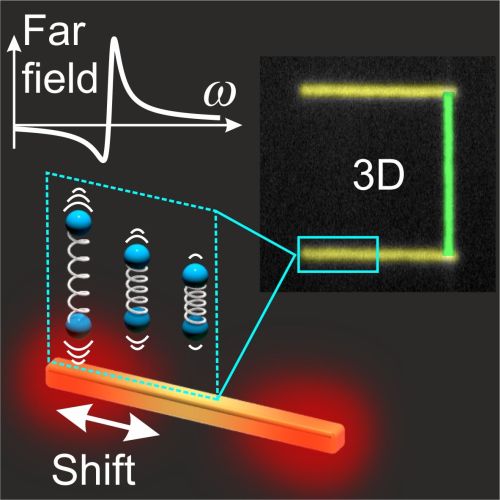July 29, 2013
Researchers at the University of Stuttgart measured for the first time optical near-field intensities of three-dimensional nanoantennas. The team of Prof. Harald Giessen at the 4th Physics Institute achieved those results with a novel scheme of nanospectroscopy and published their paper in the journal “Nature Communications”.*) Their method gives new insight into light-matter coupling at the nanoscale and allows precise measurement of enhanced optical near-field intensities generated by optical antennas. This technique can facilitate the engineering of future sensing platforms with extremely high sensitivity.
Molecules exhibit vibrational resonances in the mid-infrared and terahertz regions which is called the molecular fingerprint since it is unique for each substance. With far-field spectroscopy techniques, molecules can be detected and unambiguously identified. Nevertheless, huge quantities of molecules are needed since the excitation of the vibrational resonances is very inefficient. Metallic optical nanoantennas are resonant to incident radiation and generate high near-fields in their direct vicinity. These intensive fields can be used to make small amounts of molecules or even single molecules visible. This plays an important role in early disease diagnostics and in the detection of harmful substances or explosive gas mixtures, such as hydrogen in air.
The Stuttgart group was able to position a few molecules next to gold nanoantennas. Using electron-beam lithography they achieved an accuracy as small as a few nanometers. Due to the high near-field intensities the excitation of the molecular vibrations was orders of magnitude more efficient and was measurable with far-field spectroscopy techniques. By positioning the molecules at different locations with respect to the optical gold nanoantenna the underlying physical process of the vibrational excitation was identified for the first time. In particular, the team of researchers found that the efficiency of the vibrational excitation scales linearly with the near-field intensity generated by the optical antennas.
With this insight the researchers developed a new method to measure quantitatively near-field intensities of optical nanoantennas. The resolution limit of conventional microscopy was overcome since the detection volume using the molecules was much smaller than the wavelength cubed. Compared to state-of-the-art optical near-field microscopy, the method of the Stuttgart group exhibits the unique advantage of measuring near-field distributions of three-dimensional nanoantenna structures. Daniel Dregely was able to incorporate molecules at specific locations during the fabrication process of the antenna structure. He could then detect the vibrational excitation and thus measure the near-field intensity. Such complex nanostructures add another degree of freedom to enhance the interaction of light with single molecules at the nanoscale. The design of future sensing devices will benefit from this new tool of assessing near-field intensities of three-dimensional optical antennas.
*) Reference: D. Dregely, F. Neubrech, H. Duan, R. Vogelgesang, and H. Giessen, “Vibrational near-field mapping of planar and buried three-dimensional plasmonic nanostructures”, Nature Communications (2013). http://www.nature.com/naturecommunications
Source:















